AIM-9J Sidewinder
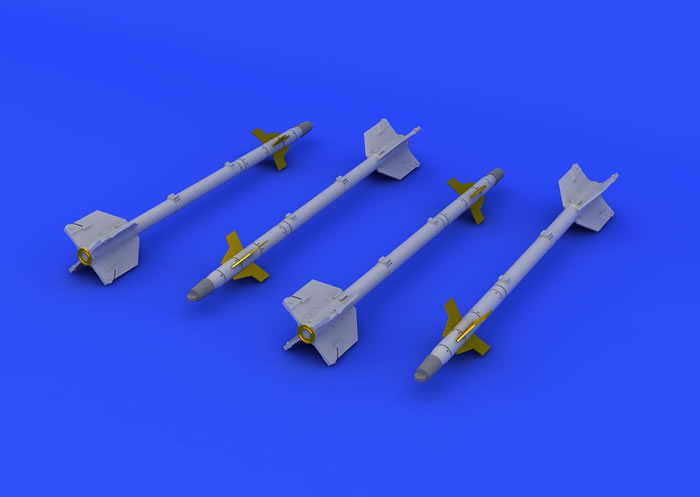
(CAD illustration courtesy of Eduard website)
Eduard BRASSIN, 1/72 scale
S u m m a r y : |
Catalogue Number |
Eduard BRASSIN Item No. 672064 - AIM-9J Sidewinder |
Contents and media |
Eight resin parts, a PE fret of twenty-six pieces, and decals. |
Scale |
1/72 |
Price: |
Available online from these stockists:
|
Review Type |
First Look |
Advantages: |
Superb quality and spare PE parts. |
Disadvantages: |
|
Recommendation: |
Eduard Brassin’s AIM-9J Sidewinders are very nicely rendered. They offer an excellent detail refinement opportunity for many modern Western fighter subjects. I definitely recommended them. |
Reviewed by Mark Davies

Eduard's BRASSIN 1/72 AIM-9J Missiles are available online from Squadron.com
The AIM-9 Sidewinder is a short-range air-to-air missile developed by the United States Navy in the 1950s. Entering service in 1956, variants and upgrades remain in active service with many air forces after five decades. The United States Air Force purchased the Sidewinder after the missile was developed by the United States Navy at China Lake, California.
A second generation of the missile (AIM-9G/H/J) was introduced during 1970 and these were followed from the mid-seventies by the AIM-9L/P) which was a substantial improvement on the early versions particularly with an improved SR-116 reduced-smoke rocket motor. The third generation of the missile (AIM-9L/M) is all-aspect missile which share little in common with the earlier missiles.
The original AIM-9B was developed by the Navy and eventually (reluctantly) adopted by the USAF (after its 'preferred solution' AIM-4 Falcon proved to be about as useful as a bottle rocket). For a variety of reasons, the USAF continued to improve upon this design while the Navy went in a different direction. The AIM-9B used the AERO 3 launch rail and was used in Vietnam during Operation Rolling Thunder. The USAF produced an improved missile, the AIM-9E, with a more pointed seeker, that was the normal missile used by USAF F-4 MiGCap aircraft during Operation Linebacker in 1972. In August of 1972, a limited number of AIM-9Js were introduced with their distinctive double delta fins. Following Vietnam, this configuration received internal improvements, resulting in the AIM-9N and -9P designations. The AIM-9Ps continued to be used by the USAF, albeit in decreasing numbers, into the 1990s.
The Navy introduced a completely new missile that bore a superficial resemblance to the original missile in the mid-1960s, which required a new launch rail, the LAU-7, to hold the nitrogen bottle used to cool its IR seeker. The radar-guided AIM-9C was used exclusively by the F-8 Crusader to provide Midway class carriers with a (limited) night intercept capability. The IR-guided AIM-9D was employed by F-8s and F-4s during Rolling Thunder, which ended in 1968. It was largely replaced by the AIM-9G by the start of Linebacker. After Vietnam, the AIM-9H was the Navy's standard IR missile throughout most of the rest of the 1970s. The AIM-9D/G/H were externally indistinguishable. The AIM-9Cs had a different seeker section with a hemispheric radome and slightly larger fins. It was retired late in the Vietnam war, but the roughly 1,000 seekers were retained and modified in the early 1990s to become the AGM-123 anti-radiation missile carried by USMC aircraft and helicopters during Operation Desert Storm.
The AIM-9L, which became operational in the early 1980s was distinguishable from the D/G/H by its cranked delta fins. The 'Lima's' main use in combat was with Royal Navy Harriers during the Falklands conflict, where its all-aspect firing envelope proved devastating. It was a joint missile used by the USAF as well as the USN/USMC. The USAF Sidewinders differed in that they used a small bottle of Argon in the seeker for cooling, allowing them to use different launchers (e.g., the LAU-105 for the A-10 and F-4, and LAU-114 for the F-15). By the mid-1980s it was replaced in US service by the externally identical AIM-9M, which saw extensive combat use beginning with Operation Desert Storm.
A true third generation Sidewinder, the AIM-9X, was introduced during the course of Operations Enduring and Iraqi Freedom. Although it retained the AIM-9M's warhead and rocket motor, it is truly another unique design that should have been given a new designation (as the second generation missiles should have). However, the name Sidewinder has come to embody short-range IR guided missiles to US politicians, so it was politically expedient to retain the name and designation.
(Historical background by Jim Rotramel)
The four missiles come attractively packaged in a blister pack with sponge cushioning.
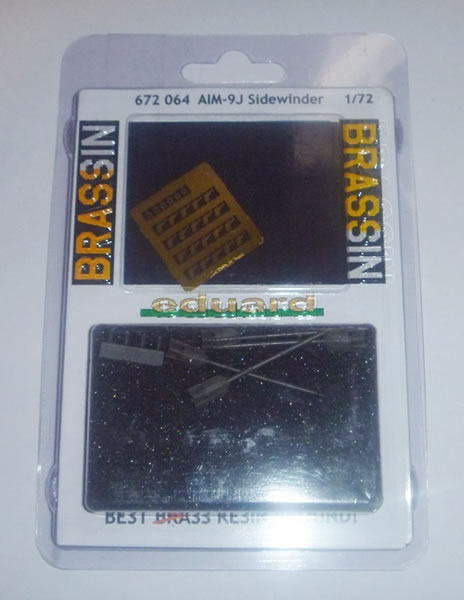
Very clear instructions are included, with colour call-outs cross-referenced to the Gunze Aqueous and Mr Color paint ranges. A PDF copy of the instructions is downloadable from Eduard’s website.
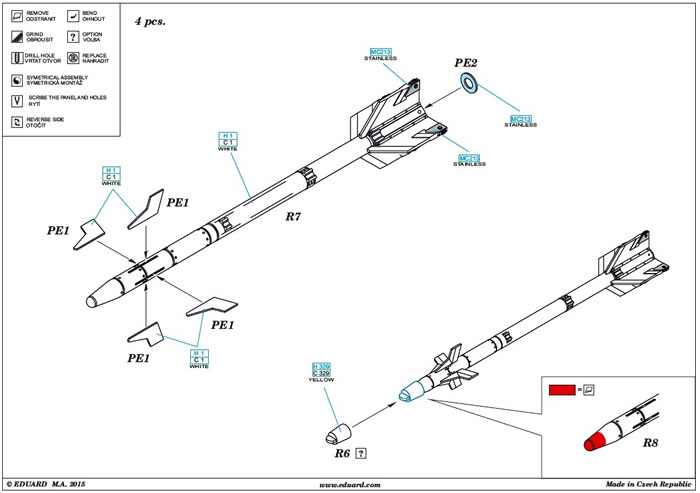
A small sheet of decals provides for the missile markings.
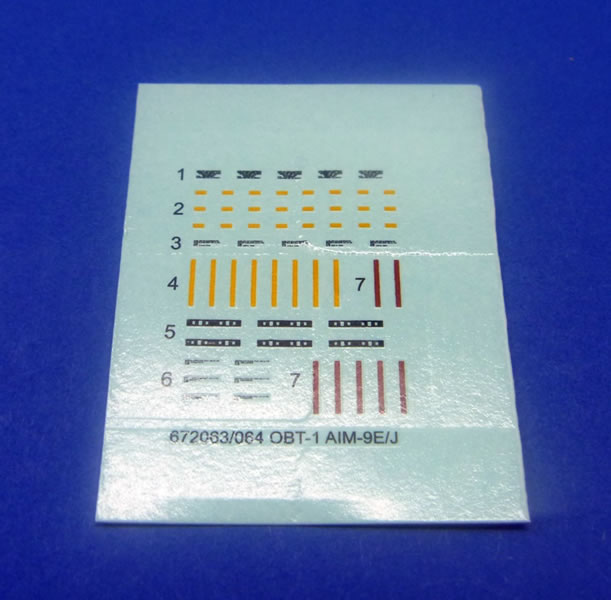
The quality of casting is excellent, with the pour subs attached to the tail fins. Separate protective covers for the seeker-heads are supplied in resin, but you will have to cut the seeker-heads from the missile fuselages if you plan to use these. The forward fins are made of PE; sixteen being required to complete four missiles, although twenty are supplied, so you have four spare. Six PE rings are included to represent the rocket motor exhausts, so two are spare.

Painted and decaled, these Sidewinders should be an excellent addition to any suitable model; they are sure to be a vast improvement over any injected kit items.
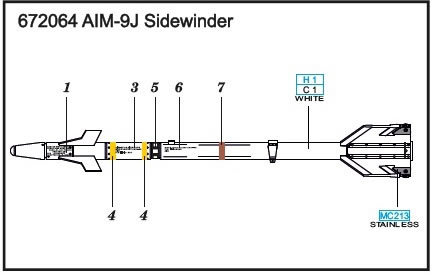
Unlike several of their other Eduard AIM-9 Sidewinder sets, Eduard has yet to offer the AIM-9J in 1/48 as well as 1/72 scale.
Eduard Brassin’s AIM-9J Sidewinders are very nicely rendered. They offer an excellent detail refinement opportunity for many modern Western fighter subjects. I definitely recommended them.
Thanks to Eduard for the samples and images.
Review Text Copyright © 2015 by Mark Davies
Page Created 21 October, 2015
Last updated
23 October, 2015
Back to HyperScale Main Page
Back to Reviews Page

|
